Accelerator Based Atomic and Molecular Physics
Highly charged ions (HCI) are highly ionized atoms. They occur in nature in solar winds, hot stars and stellae coronae, interstellar and inter galactic mediums, Earth's upper atmosphere, or in earth's atmosphere during thunderstorms. The study of HCI is important for a variety of fields such as astrophysics, plasma physics, accelerator physics, internal fusion, etc. Accelerator-based Atomic and Molecular Physics studies focus on HCI produced using ion accelerators. Some of the key areas in which research is being pursued at IUAC with HCI are beam foil and beam two foil spectroscopy, circular Rydberg states, lifetime, high-resolution multi-channel Doppler tuned x-ray spectroscopy, Surface effect on post foil charge state distribution, Recoil Ion Momentum spectroscopy etc.
Facilities
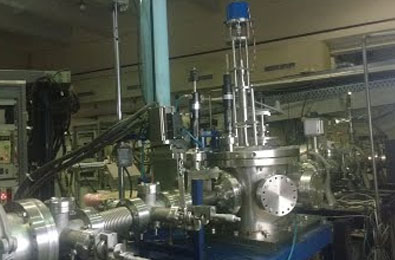
General Purpose Atomic Physics Chamber (GPAC)
GPAC is a stainless-steel chamber installed at 300 beamline of beam hall-2 at IUAC. The height of the chamber is 316 mm and its internal diameter is 356 mm. The chamber mounted on rigid raw steel support was designed to carry out atomic physics experiments. The essential features of the chamber include:
- Computer controlled movable foil setup mounted on the horizontal rail that can be used for standard time of flight experiments
- An arrangement for holding multiple foils in a ladder is made.
- Two x-ray detectors can be simultaneously mounted at right angles to the beam axis to observe the decay of excited states in the post-foil beam.
- The chamber has an exit port for the post foil beam which facilitates the further study of the post-foil beam by using an Electrostatic analyzer and position sensitive detector for post foil charge state analysis.
- The base and the top flange of the chamber has M6 tapped holes at 15 degrees to mount different experimental accessories like mounting arrangement for SSBD detectors.
- Chamber has been coupled with a dedicated 250 l/s turbo-molecular pump to achieve 10-7 mbar vacuum within two hours.
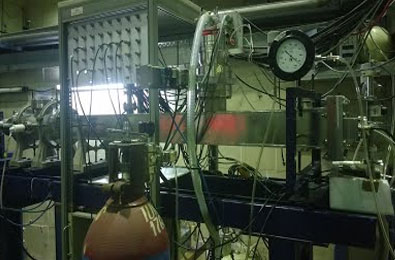
Straight and Inclined Electrostatic Analyser
Knowledge of post foil charge state distribution is always useful in selecting the beam energy for a particular charge state of interest with maximum yield. For studying the charge state fraction in post foil, we are in the process of developing a new technique involving an Inclined and Straight Electrostatic Analyser (ISESA) in which one plate is held parallel and the other kept inclined at a certain angle relative to the beam axis in beam hall -2. Therefore an ISESA is asymmetric about the beam axis. It is essential to apply the voltages to the plates in such a manner that the beam is deflected towards the inclined one. A small gap (10mm) between the plates at the entry causes large deflections due to the high field. As the ions move forward, the gap increases (causing a lower field) so that the ions can escape without hitting the plate. This inclination of one deflecting plate allows better resolution of charge states and increases the number of charge states escaping without hitting the plate also. Two beam collimating slit systems are placed to align the beam with the axis of the ISESA. ISESA is being used to deflect the post foil charge state so that deflected ions in the field region do not hit the plate at the exit. A trapper drift tube chamber of 1.5 m long is used to transfer ions tangentially after passing the ISESA. The trapper drift tube chamber provides an opportunity to place a 220 mm long Position Sensitive Proportional Counter (PSPC). A P-10 gas-filled PSPC is used to measure the position of different charge states simultaneously. There is one viewport at the end of the beamline and the insertable Faraday cup placed at the end of the vacuum chamber is used to monitor the beam current throughout the experiment. A vacuum control system has been designed to create a high vacuum inside the trapper drift chamber and ISESA. To achieve the desired vacuum, one turbopump (300 l/sec) is employed on the trapper drift tube chamber. To measure the vacuum inside the ISESA, a Pirani gauge and a full range cold cathode gauge are used more... ![]()
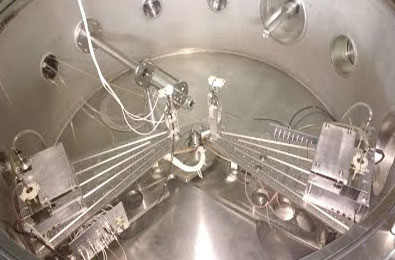
Multi Channel Doppler Tuned Spectroscopy
Doppler Tuned Spectrometer is a novel spectrometer for X-ray emitting from fast foil excited ion beam. The spectrometer makes use of a large Doppler shift to bring the emission spectrum into coincidence with known features (such as k-edge) of the absorption spectrum of suitable filter material. Tuning is accomplished by varying the angle between the beam and the detector, with the filter material between the source foil and detector. Knowledge of the beam velocity, angle, and absorption spectrum of the filter is sufficient to determine the emission spectrum from the beam. A long one-dimensional position-sensitive proportional counter is used as an X-ray detector in this setup. Position sensitive proportional counter with a single anode wire was tested for X-ray detector by utilizing high-pressure counting gas, up to 1 atm. As a position sensing electrode, a flat-cathode with a backgammon pattern is employed. The position readout has successfully been performed to provide the position resolution of 591 μm for 5.9 keV X-rays with the use of 900 bar at 1550 voltage. A unique Soller slit assembly coupled with a long one-dimensional position-sensitive proportional counter enables us to get distinct x-ray peaks at different angles, which allows us to cover a large number of angles in one shot. A lifetime setup is also used. more... ![]()
Life time setup
The lifetime setup for standard beam-foil and beam-two-foil spectroscopy is used in GPAC. The setup gives 100 mm of flight length giving access to a lifetime study of metastable states. Three actuator motors are used to make the target move linear. The least number of these motors is 1 µm. A recent experiment carried out include the lifetime study of metastable states of highly charged Titanium ions at various beam energies.
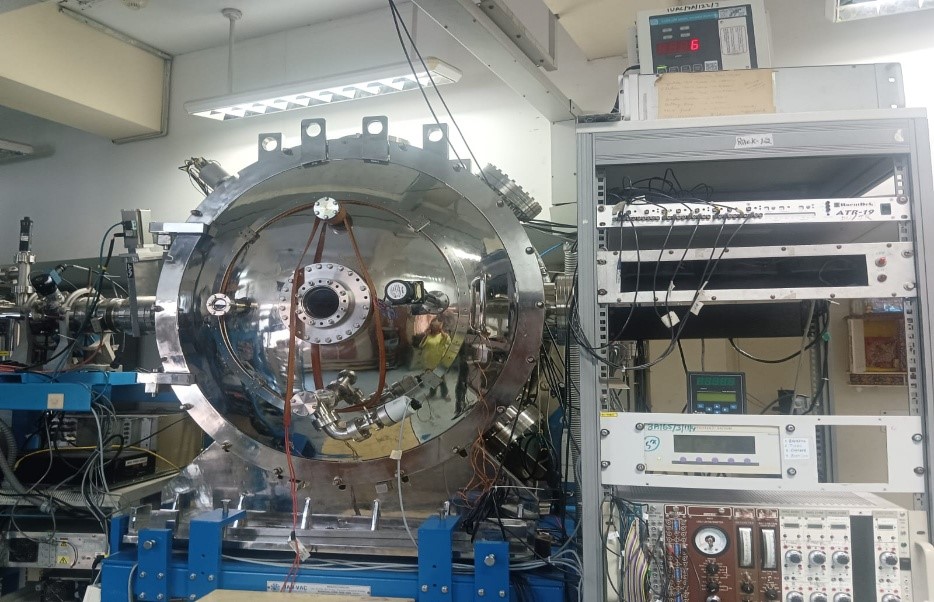
Recoil Ion Momentum Spectroscopy (RIMS)
The 1050 beam line of the Low Energy Ion Beam Facility (LEIBF) at IUAC is equipped with a Recoil Ion Momentum Spectrometer (RIMS), designed for the studies of ion-molecule interactions. Ions for these experiments are produced using a 10 GHz Electron Cyclotron Resonance (ECR) ion source, which delivers a wide range of highly charged ion beams (Energy range: 50 keV – 2 MeV) with excellent stability and control. The RIMS setup is based on the Wiley–McLaren time-of-flight geometry. This setup enables three-dimensional momentum imaging of recoil ions produced during ion-molecule collisions. The spectrometer consists of Microchannel Plate (MCP), Position sensitive detector and Channel Electron Multiplier (CEM) as detectors and allows multi-hit coincidence measurements essential for studying complex fragmentation dynamics. Gaseous molecules and low vapour pressure liquids can be used as the targets. RIMS facilitates detailed investigation of ionization, electron capture, and capture-ionization processes by correlating the recoil fragments with the charge states of scattered projectiles.
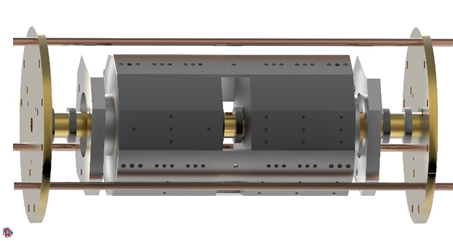
Ion trap
The Delhi Penning Trap (DPT) at IUAC is an open endcap cylindrical Penning trap. In DPT, a quadrupolar electrostatic potential is used for the confinement of ions along the central axis of the trap (axial confinement), while a homogeneous magnetostatic field (1.1 T NdFeB magnet) along the same axis provides the radial confinement. The overall setup is constituted by a UHV vacuum chamber that houses the Penning trap with its permanent magnet along its central axis. The trap, magnet and electronics are surrounded by a thermal shield that is cooled to liquid-nitrogen temperature by a cryostat placed on top of the chamber. The setup has successfully completed its initial commissioning phase and is partially operational under both room temperature and cryogenic conditions. A vacuum system integrated with the DPT currently achieves a base pressure of 5×10−8 mbar at room temperature. A Kimball Physics Electron Gun based on thermionic emission, is installed and operational. It is used for the initial trap characterization by ionizing residual or introduced gases at the trap centre. A Channel Electron Multiplier (CEM) is used for the detection of ions in destructive method. Storage time measurement protocols for trapped ions are under development and will be implemented alongside the axial resonator commissioning. The complete system is projected to be installed at the Free Electron Laser (FEL) beam line enabling studies of relativistic electron-impact ionization of highly charged ions.

Charge State Distribution studies
Charge state distribution (CSD) studies aim to understand how highly charged ions (HCIs) evolve as they interact with thin solid targets. These studies primarily focus on post-foil charge state distributions, providing insights into the electron capture and loss processes that occur when fast-moving HCIs traverse through matter. In addition to these processes, the influence of the exit surface on electron capture can also be studied to gain a more comprehensive understanding of ion-solid interactions. Furthermore, the energy loss experienced by ions during ion–solid collisions can be measured, and the effect of equilibrium and non-equilibrium target thickness on this energy loss can be systematically investigated.
Contact Persons

Dr. C.P. Safvan
Scientist-H
[Program Leader]
Ext:327
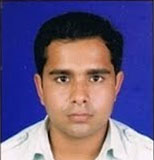
Mr. Deepak Kumar Swami
Scientist - D
[Lab Incharge]
Ext:8868

Ms. Veena C P
Scientist - C
[Group Member]
Ext:8868
Publications
-
1. State selectivity in core ionization of methane
Rajput, J. and Stindl, J. and Cassimi, A. and Gervais, B. and Kircher, M. and Kastirke, G. and McGinnis, O. D. and Enoki, R. and Williams, J. B. and Davis, V. and Saha, R. and Kumar, S. and Kostko, O. and Shaikh, M. and Weber, Th. and Slaughter, D. S. and Iwamoto, N. and Bagdia, C. and Ben-Itzhak, I. and Sch\"offler, M. S. and Safvan, C. P, Phys. Rev. Res. 7, L022021 (2025). DOI: 10.1103/PhysRevResearch.7.L022021
-
2. Hydrogen scrambling and high propensity for multiple neutral emissions from 1,3-butadiene dication
Pooja Kumari, C. P. Safvan, Aakash Dixit, Jatin Yadav, Dariusz G. Piekarski, Jyoti Rajput, J Chem. Phys 162 , 164302 (2025). DOI: 10.1063/5.0244970
-
3. Intramolecular scattering in dissociating multiply charged diiodoacetylene
Manisha Samal, Pragya Bhatt, H. Tezuka, G. Veshapidze, C. P. Safvan, J. Matsumoto, H. Shiromaru, and Sankar De, Phys. Rev. A 111, 032819 (2025). DOI: 10.1103/PhysRevA.111.032819
-
4. Equilibrium and non-equilibrium charge state distribution of fast Ti+p ion in carbon target
D. K. Swami, Pragya Bhatt , Sunil Ojha , Veena C. P., Krishan K. Pal , Aditya Kumar, Balwinder Singh , Manish K. Verma and R. K. Karn, J Phys B : At. Mol. Opt. Phys. 58, 115203 (2025). DOI: 10.1088/1361-6455/addf99
-
5. Charge state distribution for 1.78–3.93 MeV/u Si projectiles passing through 10 μg/cm2 carbon foil
D.K. Swami, Sarvesh Kumar, S. Ojha, and R.K. Karn, Rad. Phys. Chem. 229 112462 (2025). DOI: 10.1016/j.radphyschem.2024.112462
-
6. Measurement of Arq+ ion induced tungsten M x-ray relative intensity ratio with energy dependence
D.K. Swami, Balwinder Singh, Sandeep Kaur, and R.K. Karn, Vacuum 234 114085 (2025). DOI: 10.1016/j.vacuum.2025.114085
-
7. M X-ray production cross-sections in Yb induced by nitrogen ions
Balwinder Singh, Shehla, Anil Kumar, D.K. Swami, Ajay Kumar, and Sanjiv Puri, Spec. Lett. 1-6 (2025). DOI: 10.1080/00387010.2025.2543940
-
8. A differentially pumped windowless charge exchange cell (CEC) for investigating Positive Ion Mass Spectrometry (PIMS)
Nabajyoti Pandit, A. Barthakur, Rasna Baruah, M. Baro, P. Barua, J.J. Das, V.M. Datar, S.S. Ghugre, M. Patgiri, P.C. Rout, C.P. Safvan, S. Santra, G.C. Wary, Nucl. Inst. Meth. Phys. Res. A 1069, 169913 (2024). DOI: 10.1016/j.nima.2024.169913
-
9. Energy and Z dependence of low velocity Nq+ ion induced M X-ray relative intensities for some heavy elements
Balwinder Singh, Shehla, Anil Kumar , Deepak Swami, Ajay Kumar, and Sanjiv Puri, Rad. Phys. Chem., 222, 111820 (2024). DOI: 10.1016/j.radphyschem.2024.111820
-
10. Addressing three-body fragmentation of methane dication using “native frames”: Evidence of internal excitation in fragments
Jyoti Rajput, Diksha Garg, A. Cassimi , X. Fléchard, J. Rangama, C. P. Safvan, J. Chem. Phys., 159, 184303 (2023). DOI: 10.1063/5.0171881
-
11. Fragmentation of Multiply Charged C10H8 Isomers Produced in keV Range Proton Collision Meloottayil
V. Vinitha, Pragya Bhatt, Cholakka P. Safvan ,Sarita Vig and Umesh R. Kadhane, Atoms : 11, 138 (2023). DOI: 10.3390/atoms11110138
-
12. Fragmentation dynamics of tetrachloromethane molecule induced by highly charged Ar7+ - ion impact
Nirmallya Das, Sankar De, Pragya Bhatt, C. P. Safvan, and Abhijit Majumdar, J Chem. Phys., 158, 084307 (2023). DOI: 10.1063/5.0135440
-
13. Exploring three-body fragmentation of acetylene trication
Jatin Yadav, C P Safvan, Pragya Bhatt, Pooja Kumari, Jasmeet Singh and Jyoti Rajput, J Chem. Phys., 158, 074302 (2023). DOI: 10.1063/5.0135441
-
14. Exploring the influence of target atomic number (Z2) on mean equilibrium charge state (q): A comprehensive study
D. K. Swami, Sarvesh Kumar, Balwinder Singh, and R. K. Karn, Front. Phys., 11 (2023). DOI: 10.3389/fphy.2023.1145632
-
15. Fragmentation dynamics of CH3Clq+ (q = 2,3): theory and experiment
Pragya Bhatt, K. R. Maiyelvaganan, M. Prakash, J. Palaudoux, C. P. Safvan, M. Hochlaf, Phys. Chem. Chem. Phys. 24, 27619-27630 (2022). DOI: 10.1039/D2CP02194C
-
16. Fragmentation dynamics of diatomic molecules under proton impact: Kinetic energy release spectra of COq+ and NOq+ (q = 2, 3) molecular ions
Avijit Duley, Narendra Nath Dutta, C. Bagdia, L. C. Tribedi, C. P. Safvan & A. H. Kelkar, Euro. Phys. Jour. D, 76, 162 (2022). DOI: 10.1140/epjd/s10053-022-00473-9
-
17. Hydrogen migration in triply charged acetylene
Jatin Yadav, C.P. Safvan, Pragya Bhatt, Pooja Kumari, Aditya Kumar, Jyoti Rajput, J. Chem. Phys., 156, 141101 (2022). DOI: 10.1063/5.0086427
-
18. Unexplained dissociation pathways of two-body fragmentation of methane dication
Jyoti Rajput, Diksha Garg, Amine Cassimi, Alain MERY, Xavier Flechard, Jimmy Rangama, Stéphane Guillous, Wael Iskandar, Aditya Narayan Agnihotri, J. Matsumoto, Rajeev Ahuja, and C. P. Safvan, J. Chem. Phys., 156, 054301 (2022). DOI: 10.1063/5.0079851
-
19. Inner-shell ionisation of Xeq+ -Au and Pb collision systems: MO picture
C.V. Ahmad, R. Gupta, K. Chakraborty, D.K. Swami, and P. Verma, Nucl. Instr. Meth. Phys. Res. B, 531 9-23 (2022). DOI: 10.1016/j.nimb.2022.08.010
-
20. Dissociation dynamics in chloroform molecule induced by ion impact
Nirmallya Das, Pragya Bhatt, Sankar De, C.P.Safvan, and Abhijit Majumdar, International J. Mass Spectr., 469, 116684 (2021). DOI: 10.1016/j.ijms.2021.116684
-
21. A new technique for measurement of subrotational lifetime of molecular ions
J Rajput, H Kumar, P Bhatt, and CP Safvan, Scientific Reports, 10, 20301 (2020). DOI: 10.1038/s41598-020-77408-0
-
22. Triple ionisation of OCS: orientation dependence in the case of ion impact
Deepak Sharma, Bhas Bapat, Pragya Bhatt and C P Safvan, J. Phys. B: At. Mol. Opt. Phys. 53 155202 (2020). DOI: 10.1088/1361-6455/ab9151
-
23. A Sensitive On-Chip Probe based Portable Nuclear Magnetic Resonance for Detecting Low Parasitemia Plasmodium Falciparum in Human Blood
Manish Gupta, Kundan Singh, Daya Krishan Lobiyal, Cholakka Parambath Safvan, Bhuban Kumar Sahu, Preeti Yadav, and Shailja Singh, Med. Devi. Sens., (2020) Wiley. DOI: 10.1002/mds3.10098
-
24. Orientation dependence of multiple ionisation of a diatomic molecule under proton impact
Deepak Sharma, Bhas Bapat, Pragya Bhatt and C P Safvan, J. Phys. B 52, 115201 (2019). DOI: 10.1088/1361-6455/ab17ee
-
25. Properties of a cylindrical Penning trap with conical endcap openings
Sugam Kumar, W Quint, S Ringleb, C P Safvan, N Stallkamp, Th Stöhlker and M Vogel, Physica Scripta, 94, 075401 (2019). DOI: 10.1088/1402-4896/ab0aaa
-
26. Radio Frequency Planar Coil based On-Chip Probe for portable Nuclear Magnetic Resonance
Manish Gupta, C. P. Safvan, Kundan Singh, D. K. Lobiyal, Preeti Yadav, and Shailja Singh, IEEE Sensors Journal 19, 2500 (2019). DOI: 10.1109/JSEN.2018.2887274
-
27. Low energy carbon ion induced M X-ray relative intensities for 70Yb, 82Pb and 83Bi
Shehla, Ajay Kumar, Anil Kumar, Deepak Swami, and Sanjiv Puri, Nucl. Inst. Meth. Phys. Res. B, 458 130-135 (2019). DOI: 10.1016/j.nimb.2019.08.005
-
28. Plasmon excitation and subsequent isomerization dynamics in naphthalene and azulene under fast proton interaction
M. V. Vinitha, P. K. Najeeb, A. Kala, P. Bhatt, C. P. Safvan, S. Vig, and U. Kadhane, J. Chem. Phys. 149 194303 (2018). DOI: 10.1063/1.5046464
-
29. Anisotropy in multiple ionisation of CO by ion collisions at intermediate interaction strengths
Deepak Sharma, Bhas Bapat, Pragya Bhatt and C P Safvan, J. Phys. B 51 195202 (2018). DOI: 10.1088/1361-6455/aadc93
-
30. Three-body dissociation of OCS3+: Seperating sequential and concerted pathways
Herendra Kumar, Pragya Bhatt, C. P. Safvan, and Jyoti Rajput, J. Chem. Phys. 148 064302 (2018). DOI: 10.1063/1.5001121
-
31. Present status of theoretical understanding of charge changing processes at low beam energies
D.K. Swami, and T. Nandi, Rad. Phys. Chem., 153 120-130 (2018). DOI: 10.1016/j.radphyschem.2018.08.034
Last Updated: 17 October 2025



